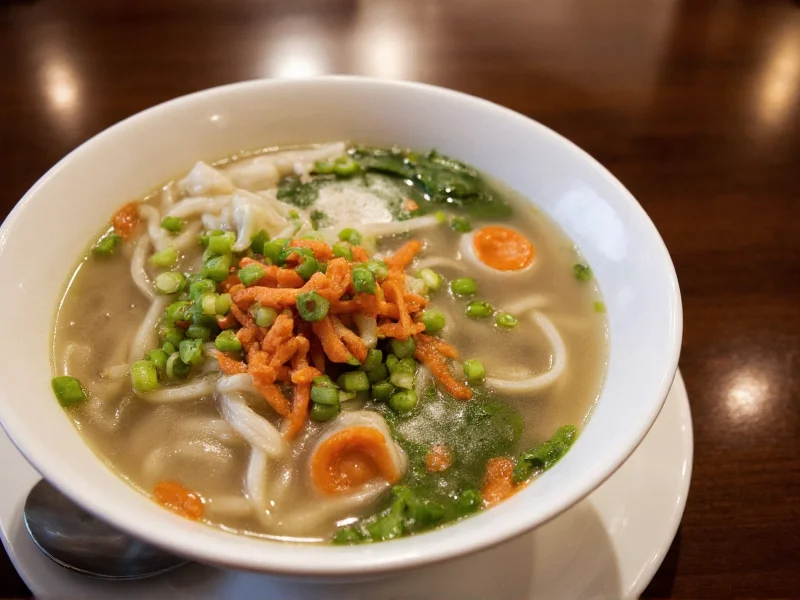The Cultural Roots of Vietnam's National Dish
Pho emerged around the turn of the 20th century in northern Vietnam, particularly in the Red River Delta region near Hanoi. Its development coincided with French colonial influence introducing beef consumption to Vietnamese cuisine—previously dominated by pork and poultry. The name likely derives from “phố,” reflecting both the dish’s visual appearance (resembling Chinese “fen” noodles) and French “pot-au-feu” stew. By the 1950s, southern migration after Vietnam’s partition created distinct regional styles that define modern pho variations.
Essential Components of Authentic Pho
Three elements distinguish genuine pho from imitations: the broth, noodles, and garnish assembly. Mastering pho broth requires meticulous preparation—beef bones blanched to remove impurities, then simmered 6-12 hours with charred onion and ginger. The spice bouquet typically includes star anise, cloves, cinnamon, and cardamom toasted to release oils. Traditional pho uses flat rice noodles (bánh phồ) cut 3-5mm wide, neither overcooked nor undercooked. Garnishes arrive separately, allowing customization with Thai basil, bean sprouts, lime wedges, and sliced chilies.
| Regional Style | Broth Characteristics | Distinctive Garnishes |
|---|---|---|
| Northern (Hanoi) | Clear, subtle seasoning | Green onion, minimal herbs |
| Southern (Saigon) | Sweeter, complex spices | Bean sprouts, hoisin sauce |
| Central Vietnam | Bolder, spicier profile | Shrimp paste, fresh herbs |
Regional Variations Across Vietnam
Northern pho (pho bac) maintains minimalist elegance with clear broth emphasizing beef’s natural flavor. Southern pho (pho nam) incorporates rock sugar for sweetness and features abundant garnishes. Central Vietnamese versions often include shrimp paste and chili for heat. These differences reflect historical resource availability—northern regions prioritized broth purity during leaner times, while southern abundance allowed for sweeter interpretations. Contemporary chefs sometimes blend styles, but traditionalists insist regional authenticity matters.
Proper Pho Etiquette and Consumption
Vietnamese pho culture follows unspoken rules that enhance the experience. Never mix garnishes directly into the broth—add herbs and sprouts gradually to preserve their freshness. Dip meat pieces in sauce rather than pouring it over the entire bowl. Slurping noodles is encouraged as it aerates the broth and cools hot noodles. The ideal sequence: smell the aromatic steam, taste broth first, then alternate between meat, noodles, and herbs. Leftover broth should be sipped directly from the bowl—a sign of appreciation for the chef’s work.
Modern Interpretations and Global Influence
While traditional pho remains revered, creative adaptations have emerged globally. Vegetarian pho substitutes mushroom broth for meat stock while maintaining depth through roasted vegetables. Some chefs experiment with seafood pho or fusion elements like kimchi toppings. However, purists argue these deviate from pho’s essence—the harmony of five fundamental tastes (sweet, sour, salty, bitter, umami) in the broth. International popularity has also sparked debates about cultural appropriation versus appreciation, with many Vietnamese chefs emphasizing respect for the dish’s heritage.
Common Misconceptions About Pho
Several myths persist about this Vietnamese staple. Contrary to belief, authentic pho never contains fish sauce in the broth—it’s added tableside. The dish isn’t traditionally spicy; chili heat comes from optional garnishes. Many assume pho originated from French cuisine, but historical evidence points to indigenous development with French ingredients incorporated later. Another misconception involves cooking time—while broth requires hours, proper assembly takes minutes. Understanding these distinctions separates genuine pho knowledge from casual familiarity.
Frequently Asked Questions
What makes pho broth different from other noodle soups?
Pho broth’s uniqueness comes from its meticulous preparation process. Unlike ramen or udon broths, authentic pho requires charring onions and ginger to add smoky sweetness, then simmering beef bones 8-12 hours with toasted spices like star anise and cinnamon. The broth achieves clarity through careful skimming and uses no tomato paste or soy sauce—relying solely on bone marrow, spices, and proper technique for its complex flavor profile.
How do northern and southern Vietnamese pho differ?
Northern pho (Hanoi style) features a clear, delicate broth with subtle seasoning that highlights beef’s natural flavor, minimal garnishes, and wider noodles. Southern pho (Saigon style) incorporates rock sugar for sweetness, uses more complex spice blends, includes bean sprouts and hoisin sauce as standard accompaniments, and serves thinner noodles. These differences reflect historical resource availability and regional taste preferences across Vietnam.
What are the essential herbs for authentic pho?
Traditional pho uses four essential fresh herbs served as garnishes: Thai basil (holy basil preferred), culantro (ngội gò), green onion, and sliced chili peppers. Bean sprouts are common in southern styles. These aren’t mixed into the broth but added individually to preserve their distinct flavors and textures. Each herb contributes specific elements—basil adds sweetness, culantro provides earthiness, and chilies bring controlled heat.
Is pho considered healthy in Vietnamese cuisine?
Traditional pho offers balanced nutrition when prepared authentically. The broth provides collagen and amino acids from long-simmered bones, while lean meat cuts contribute protein. Rice noodles offer easily digestible carbohydrates, and fresh herbs add vitamins and antioxidants. However, sodium content can be high depending on preparation. Many Vietnamese consider pho a restorative food—often eaten for breakfast or when recovering from illness due to its warming, easily digestible properties.
How should you properly eat pho according to Vietnamese tradition?
Vietnamese pho etiquette emphasizes gradual customization. First, smell the aromatic broth, then taste it plain to appreciate the chef’s work. Add herbs and garnishes incrementally rather than mixing everything at once. Dip meat slices in sauce instead of pouring it over the entire bowl. Slurping noodles is encouraged as it cools them and aerates the broth. The proper sequence alternates between broth sips, meat bites, and noodle slurps, finishing by drinking the remaining broth directly from the bowl as a sign of appreciation.











 浙公网安备
33010002000092号
浙公网安备
33010002000092号 浙B2-20120091-4
浙B2-20120091-4